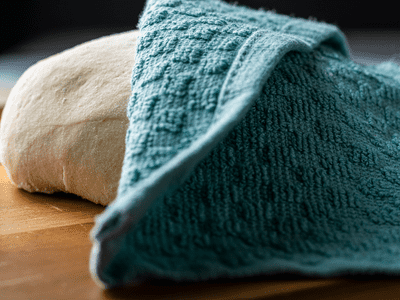Why dough temperature to cook bread is important? Do you consider the temperature of the water you use in your dough? Is tepid water cold, warm, or hot?
How warm is the water if it’s tepid? Tepid is defined as slightly warm or lukewarm in the dictionary. Tepid, as an adjective, means lacking enthusiasm, half-hearted, indifferent, or cool. I believe you’d agree that this is, at best, a hazy term that should be discarded. YET, there are numerous bread recipes that call for lukewarm water. What is the definition of tepid?
This has been tested in many of my bread-making classes. I pour tap water into a jug and ask participants to describe the temperature. I inquire whether the water is cold, tepid, warm, or hot. Each person’s response is unique. If we each follow the recipe that calls for tepid water, the results will differ because we’ll be using different temperatures of water.
What is the Significance of Temperature to Cook Bread?

The final temperature of a dough after mixing is one indicator that the dough has been sufficiently mixed to allow the yeasts to develop. If the temperature is too low, the dough will not rise properly; if it is too high, the dough will over-ferment. The ideal temperature range is 24°C to 26°C (75 to 78F).
Room temperature, flour temperature, and water temperature are all important considerations.
We must consider three temperatures to bake bread:
Using a digital thermometer to measure the temperature of the air
Temperature in the Room
You can imagine the differences if you make bread on a Polynesian island (as one of my former breadmaking classmates has to do) where the temperature is 38°C or at the British Antarctic Survey at the South Pole where the temperature approaches freezing.
Using a digital thermometer to measure the flour temperature
Temperature of the Flour
Where is the flour stored? Will it be the same temperature as the rest of the room? You’ll be surprised: even in the same room, it’s frequently cooler than room temperature.
Using a digital thermometer to measure the temperature of the water
Temperature of the Water
The temperature of the water coming from the tap varies depending on the season. If you let it run to get a really cold glass of water, you’ll know. However, the only variable that you can easily control is the temperature of the water.
Making use of the Base Temperature formula

To begin, while this is a simple formula, try using water at 22°C.
Base Temperature is a simple formula that can help you determine the proper water temperature. A digital thermometer is required (these can be obtained very cheaply). This method works for temperatures measured in degrees Celsius.
When the temperatures of the air, water, and flour are added together, the result should be 60.
Check the temperature of the air; it is 18°C.
The temperature of the flour is 16°C.
Add these two temperatures together to get 34°C.
Subtract that from 60 (the starting point) to get 26°C. This is the recommended water temperature.
If the temperature outside was much warmer, say 24°C, and my flour temperature was 20°C, my water temperature would be 16°C. If the temperature is.5 or higher, round up; if it is.4 or lower, round down.
You may be wondering what you do when the air temperature is extremely high. Bakers in extremely hot climates must store their flour in a refrigerator!
NB If you are hand kneading, make sure the water temperature is at least 22 degrees Celsius.
NB Although some professional bakers use a different Base Temperature, 60 is the most commonly used. Check out King Arthur flour’s formula if you’re using fahrenheit.
Using the proper water temperature will assist you in making better bread.
Checking the temperature of your dough

Mix by hand or in a machine using a tried-and-true bread recipe or one of my bread recipes. This applies whether you’re baking sourdough or yeasted bread.
Check the bread temperature after kneading the dough by hand for at least 10 minutes. Continue kneading if the temperature has not reached 24°C/77°F.
If you’re using a stand mixer, planetary mixer, or spiral mixer, mix the dough on low for about 5 minutes, then on high for another 5 minutes. The power of the motor in your stand mixer will determine this. At this point, check the temperature. If necessary, mix for another minute and check again. The temperature should be between 24°C and 26°C/77F.
How do I know when my dough is done?
Other indicators that your dough is sufficiently mixed include the window pane test and whether the dough has separated from the sides of the bowl. Lift and stretch your dough for the window pane test. It should be somewhat pliable. Of course, it will eventually break. If your dough is thoroughly mixed in a mixer bowl, it will come clean of the sides.
Bottom Line
Now for the magic part: if your dough has reached the proper temperature, it will rise even in the refrigerator! There is no need for a proofer.